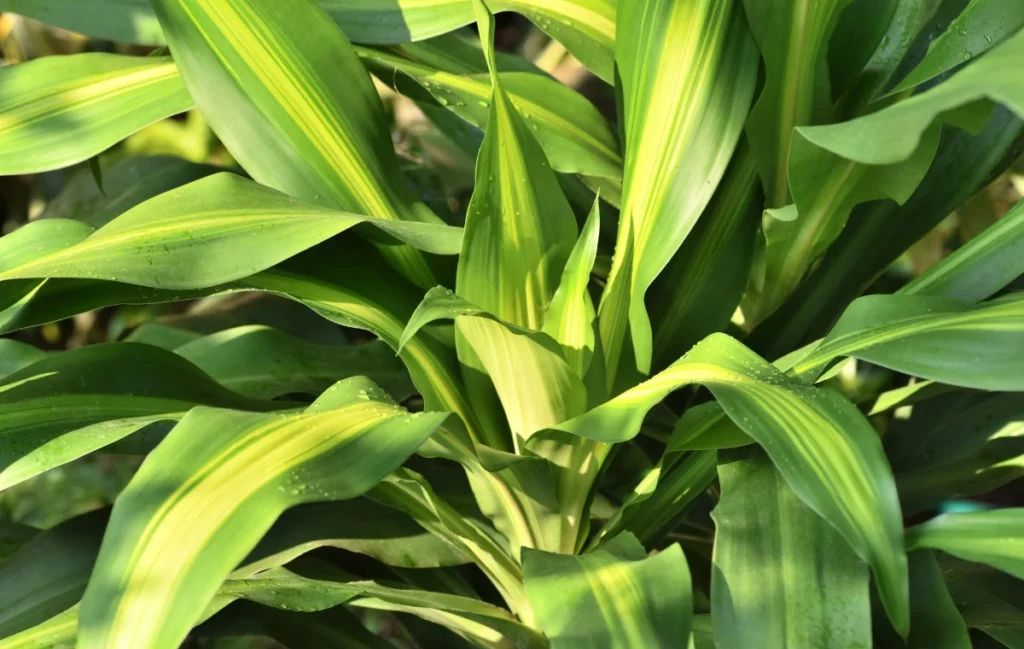The Dracaena fragrans, popularly known as the Corn Plant, is a shrubby plant with decorative foliage, widely cultivated in various parts of the world for its strong tropical appeal and resilience in indoor environments. Native to tropical Africa, it stands out for its longevity, easy cultivation, and benefits for air quality.
The botanical name Dracaena fragrans has roots in both Latin and ancient Greek. The genus Dracaena comes from the Greek “drakaina,” meaning “female dragon.” The specific epithet fragrans is Latin and means “fragrant,” alluding to the sweet scent of the plant’s flowers.

In young plants, the trunk is usually simple, but if the apical bud is damaged, it quickly develops new branches. Branching increases after each flowering. When grown in the ground, it can grow up to 49 feet (15 meters) tall and reach 12 inches (30 cm) in diameter. The leaves are large, shiny, lanceolate, and, depending on the cultivar, can be wide or narrow, solid-colored, or variegated with longitudinal stripes, with smooth or wavy edges and in different shades of green.
They emerge in terminal rosettes, often resembling a pompom: the young leaves are erect and central, and the larger leaves are curved. Its inflorescences are globose panicles, ranging from white to pink, with an intense sweet fragrance. The flowers are highly attractive to bees and hummingbirds. The subsequent fruits are smooth, orange to red berries, containing several seeds.
NASA studies have proven that the Dracaena fragrans species is effective in removing indoor pollutants such as formaldehyde, xylene, toluene, trichloroethylene, and benzene, contributing to a healthier environment. This characteristic makes the plant an excellent option for offices, living rooms, clinics, and other enclosed spaces. Besides decoration, Dracaena fragrans is widely used in landscaping due to its sculptural appearance and versatility.

It can be cultivated as an isolated shrub, in groups or rows, serving as a focal point or forming massifs, hedges, and compositions with other plants. Indoors, it is common to find potted plants, often shaped by formative pruning, beautifying various environments. Popular cultivars include ‘Compacta,’ ‘Janet Craig,’ ‘Lemon Lime,’ and ‘Sol,’ which stand out for their colorful foliage and compact size, making them ideal for indoor spaces.
Segments of the Dracaena fragrans trunk can be cultivated, even without roots, in pots with water, a practice that gave rise to the popular name Corn Plant. In this method, the leaves should be periodically misted with water and a few drops of liquid fertilizer. Avoid using tap water, which may contain fluoride harmful to the plant; prefer rainwater or mineral water. Another interesting tip is to use the Corn Plant in narrow corridors, taking advantage of its tapered silhouette that does not take up much lateral space and offers privacy, blocking external views. When planted alongside the purple false eranthemum (Barleria cristata), which grows vertically up to 4 feet (1.20 meters), a pleasant and functional visual composition is created.

The Dracaena fragrans not only contributes to the aesthetics of the environment but also offers practical benefits. Its cultivation is simple and requires little maintenance, making it ideal for beginner gardeners or people with little time to care for plants. Moreover, its ability to improve air quality makes it an excellent choice for indoor environments, especially in urban areas where air pollution can be an issue.
The diversity of available cultivars allows you to choose the Dracaena fragrans that best suits your space and decoration style. Varieties with variegated leaves, for example, add a touch of color and visual interest, while more compact cultivars are perfect for smaller spaces.
The Corn Plant can be grown in full sun, partial shade, or diffused light. Indoors, it prefers bright, indirect light. It is essential to avoid direct exposure to intense sunlight, as this can cause leaf burns. Keep the soil slightly moist, watering when the surface is dry to the touch. Avoid waterlogging the soil and, in indoor environments, ensure the pot has good drainage.

The plant prefers fertile, well-drained soil enriched with organic matter. It can be grown in different types of soil, as long as they are permeable and do not retain excess water. Additionally, it adapts well to tropical and subtropical climates, with ideal temperatures between 64°F and 77°F (18°C and 25°C). However, it does not tolerate frost or snow and should be protected from cold drafts.
Leaves with dry tips are a sign that the humidity is too low; increase the frequency of watering, reduce the use of air conditioning, and, if possible, mist the leaves with water. Fertilize the plant biweekly in spring and summer with a balanced indoor plant fertilizer, following the manufacturer’s instructions for proper dilution and application.
However, it is essential to be aware of some problems that can affect Dracaena fragrans. It is susceptible to pests such as scale insects and thrips. To avoid these problems, monitor the plant regularly and, if necessary, treat it with appropriate insecticides or natural methods, such as manually removing the pests. Additionally, the plant can be sensitive to salt buildup in the soil, which can cause leaf tip burn. In this case, it is recommended to water the plant with non-fluoridated water and perform soil flushing monthly to remove excess salts.
The Corn Plant multiplies easily by cutting branches or air layering. To do this, cut pieces of the stem 4 to 8 inches (10 to 20 cm) long, let them dry for a week, and then insert them into moist sand until they root. The plant can also be multiplied by air layering, a method that involves making a cut in the stem, removing a part of the bark, and wrapping it with moist moss until roots form.


